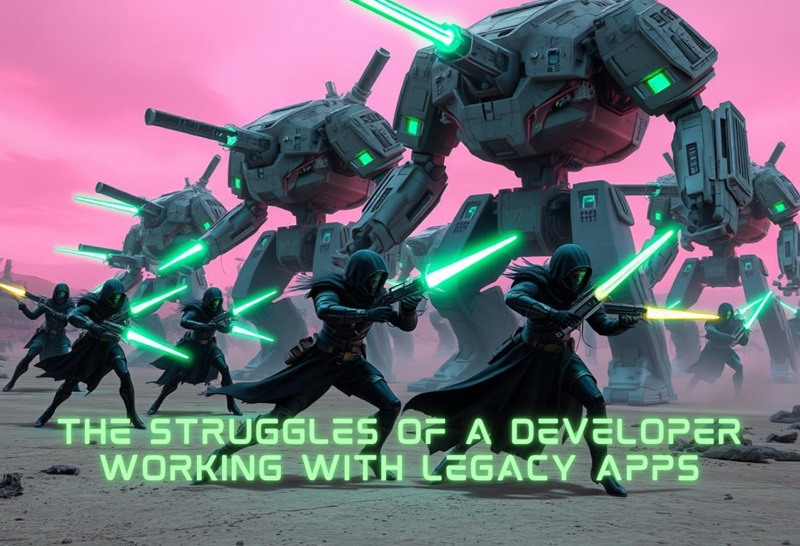
The struggles of a developer working with legacy apps
In the fast-paced world of software development, the shiny new frameworks, languages, and tools are always tempting. Developers love the idea of starting fresh, building cool new apps with cutting-edge tech. But in reality? A lot of developers spend a huge chunk of their time wrestling with legacy apps—those old, massive codebases written in languages or frameworks that feel ancient. It’s a challenge, but one that can really shape a developer’s skills and mindset in ways you wouldn’t expect.
Picture this: you land a new job, excited to work with modern technologies. But then, bam! You’re thrown into the deep end of a monolithic application built with tools that were outdated before you even started your career. It’s not uncommon, and the excitement quickly turns to frustration. The code is a mess, thousands of lines long, barely any documentation in sight, and every change feels like a game of Jenga—one wrong move and the whole thing collapses.
Tired of legacy code? Join our TechTalk on November 7
and learn how AI revolutionizes application modernization projects.
The numbers don’t lie: legacy code is everywhere
Legacy systems aren’t just occasional headaches for developers—they’re a massive part of the software landscape. In fact, studies show that 60-80% of IT budgets in large organizations are spent on maintaining legacy systems. According to a survey by Stripe and Harris Poll, developers spend more than 40% of their time working on what’s considered “bad code”—which often includes legacy codebases. That’s nearly half of a developer’s productivity spent on fixing, maintaining, or dealing with older systems, rather than building new features. A 2018 report by Deloitte also found that 74% of companies say they still rely on legacy applications for daily operations. The reason? Legacy systems are often deeply integrated into the core business processes, making them difficult to replace. So, even if you’re a developer just starting out, chances are, legacy systems will be part of your future too.
The loniless of legacy code
Working with legacy systems can feel like being on a deserted island. There’s often little to no documentation, and if you don’t have an experienced team to guide you, you’re stuck reverse-engineering the whole thing by yourself. It’s easy to start doubting yourself. “Am I the only one who doesn’t get this?”—you might wonder. But trust me, everyone has been there. And then there’s the worry about your career. Spending too long on old tech can feel like a career dead-end. You start thinking, “What if I get stuck here? Will future employers think I’m behind the curve?” The industry moves fast, and the fear of getting pigeonholed in legacy tech is real.
A real-world example: the COBOL crisis
One of the most famous examples of legacy system struggles happened in 2020 during the COVID-19 pandemic. In the U.S., state unemployment systems, many of which were built using COBOL, a programming language developed in the 1950s, couldn’t handle the sudden spike in claims. COBOL was once cutting-edge, but by the 2020s, very few developers knew how to work with it. With unemployment claims skyrocketing, states like New Jersey and Connecticut were scrambling to find developers who could fix and maintain these legacy systems. Some states even issued emergency calls for retired developers who still had COBOL expertise. This crisis highlighted the real-world consequences of relying on outdated technology. The inability to quickly scale or adapt these legacy systems cost the government time and money, and delayed financial help to millions of people. This example shows that legacy systems aren’t just an inconvenience—they can be critical to business or government operations. When they fail, the impact can be huge, and there’s no easy fix without understanding the old technology inside and out.
The unique challenge of legacy systems
One of the worst things about legacy systems? The documentation (or lack of it). Most of these systems evolve over the years with multiple developers patching things up, and if you’re lucky, there’s a README file that’s been updated sometime in the past decade. If you’re unlucky? You’re piecing together how things work by reading through endless lines of spaghetti code.
Legacy systems often rely on frameworks or languages that are no longer supported or widely used. Working with tech that’s past its prime makes everything harder—updating features, fixing bugs, or even finding resources online to help you. StackOverflow isn’t going to be much help when you’re dealing with something ancient.
Years of quick fixes and band-aid solutions turn code into a tangled mess, often referred to as “spaghetti code.” It’s unpredictable. You tweak one part of the system, and something completely unrelated breaks. The technical debt—the backlog of work created by taking the easiest path—just piles up over the years, making every new change riskier than the last.
On top of that, there’s often pressure from stakeholders to keep adding features. It’s tough to innovate when the underlying system is so fragile that even a small change could break it. You end up walking a tightrope, trying to balance the need for new features with the limitations of the existing system.
Turning legacy challenges into strenghts
Despite all these headaches, working with legacy code isn’t all bad. In fact, it can sharpen your skills in ways that newer projects can’t. When you’re navigating a legacy system, it forces you to think critically. You’ll get really good at reverse-engineering features, figuring out how complex code works, and coming up with creative solutions to fit within the system’s constraints. These are the kinds of problem-solving skills that are valuable anywhere.
Legacy code will test your patience. There will be problems that don’t have quick fixes, and Google searches won’t help. It teaches you to slow down, understand the system, and accept that you don’t know everything. And that’s okay. The process makes you more patient and open to learning.
Maintaining old systems is just as valuable (and necessary) as building new ones. Legacy systems show you firsthand the consequences of coding decisions over time. This makes you a more conscientious developer when writing new code—thinking about its long-term maintenance, not just getting it to work today.
Legacy systems often run key business processes, and working on them gives you insight into how the business operates and why certain technical decisions were made. Understanding this historical context can help you communicate better with stakeholders and make more informed decisions moving forward.
How to cope and thrive in legacy land
Rewriting a legacy system from scratch is usually impractical and risky. Instead, focus on refactoring it bit by bit. Make the code cleaner and more maintainable piece by piece. Introducing unit tests as you go will help ensure you’re not breaking things along the way.
When you’re working with little to no documentation, make your own. It doesn’t have to be a full-blown user manual, but even simple comments, a README, or a few diagrams will help both you and future developers.
Even in a legacy environment, there’s room for improvement. Start by introducing modern practices like CI/CD pipelines, version control (if it’s not already in place), and coding standards. These small changes can have a big impact on the workflow and help slowly modernize the system.
You’re not alone in this. Reach out to more experienced developers for advice, and don’t be afraid to ask questions. Pair programming or doing code reviews with others can offer new perspectives and speed up the learning process. Don’t let legacy work hold you back from staying up-to-date. Keep sharpening your skills by working on side projects, taking online courses, or contributing to open-source projects. This way, your resume stays current, and you won’t feel stuck in the past.
Conclusion: finding value in legacy code
Yes, working with legacy systems can be tough—but it’s also an opportunity in disguise. The skills you gain navigating old code will make you a stronger, more versatile developer. You’ll learn to solve tough problems, build maintainable systems, and gain a deep understanding of software development’s complexities.
So, embrace the challenge. Every seasoned developer has faced the trials of legacy code, and it’s often the experience that sets them apart. Stick with it, and you’ll come out the other side not just as a better coder—but maybe even a little wiser.
Modernize. Innovate. Lead.
Are you ready to join the fight against ancient code and increasingly costly legacy applications? Join The Re:bellion.
